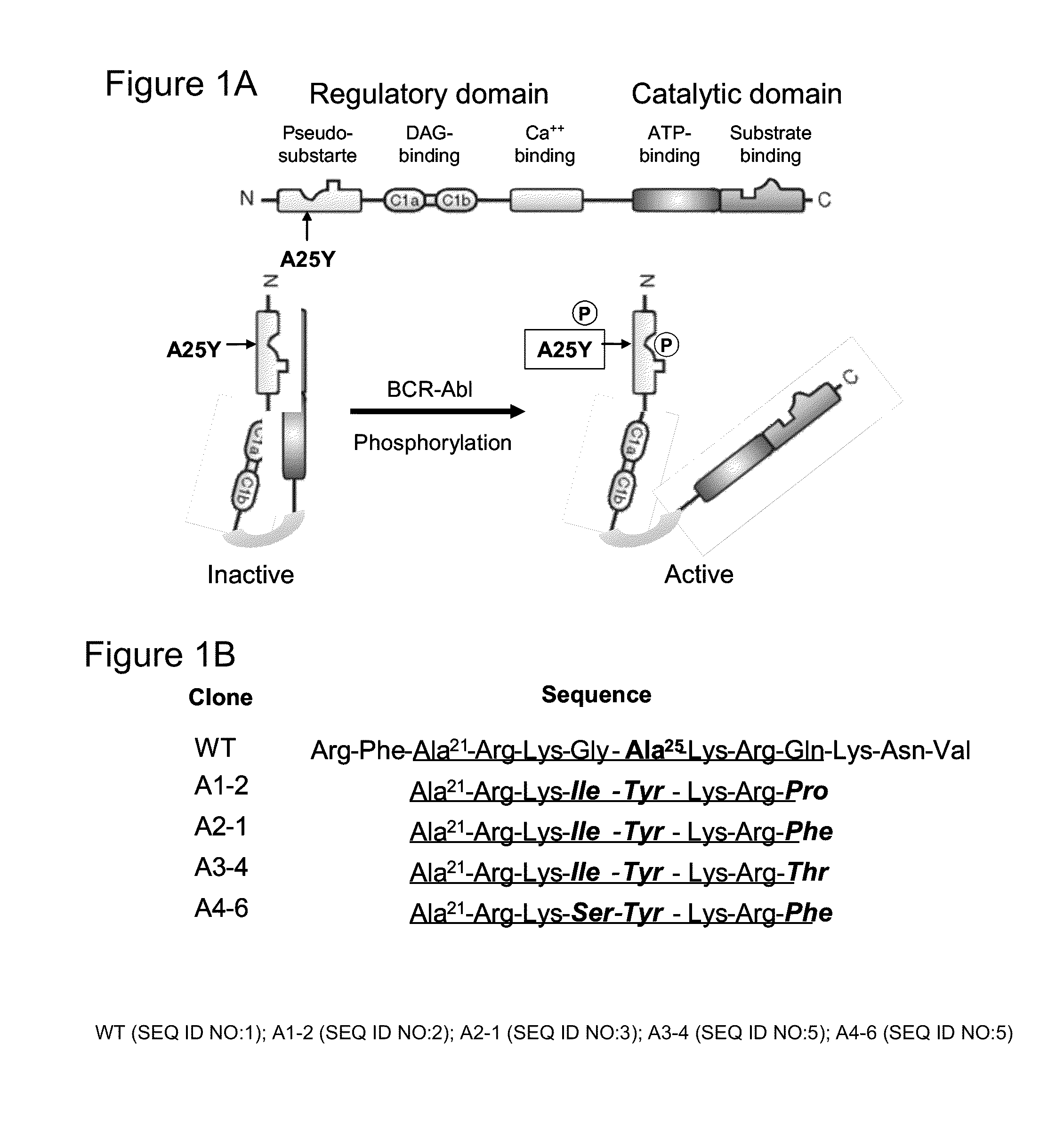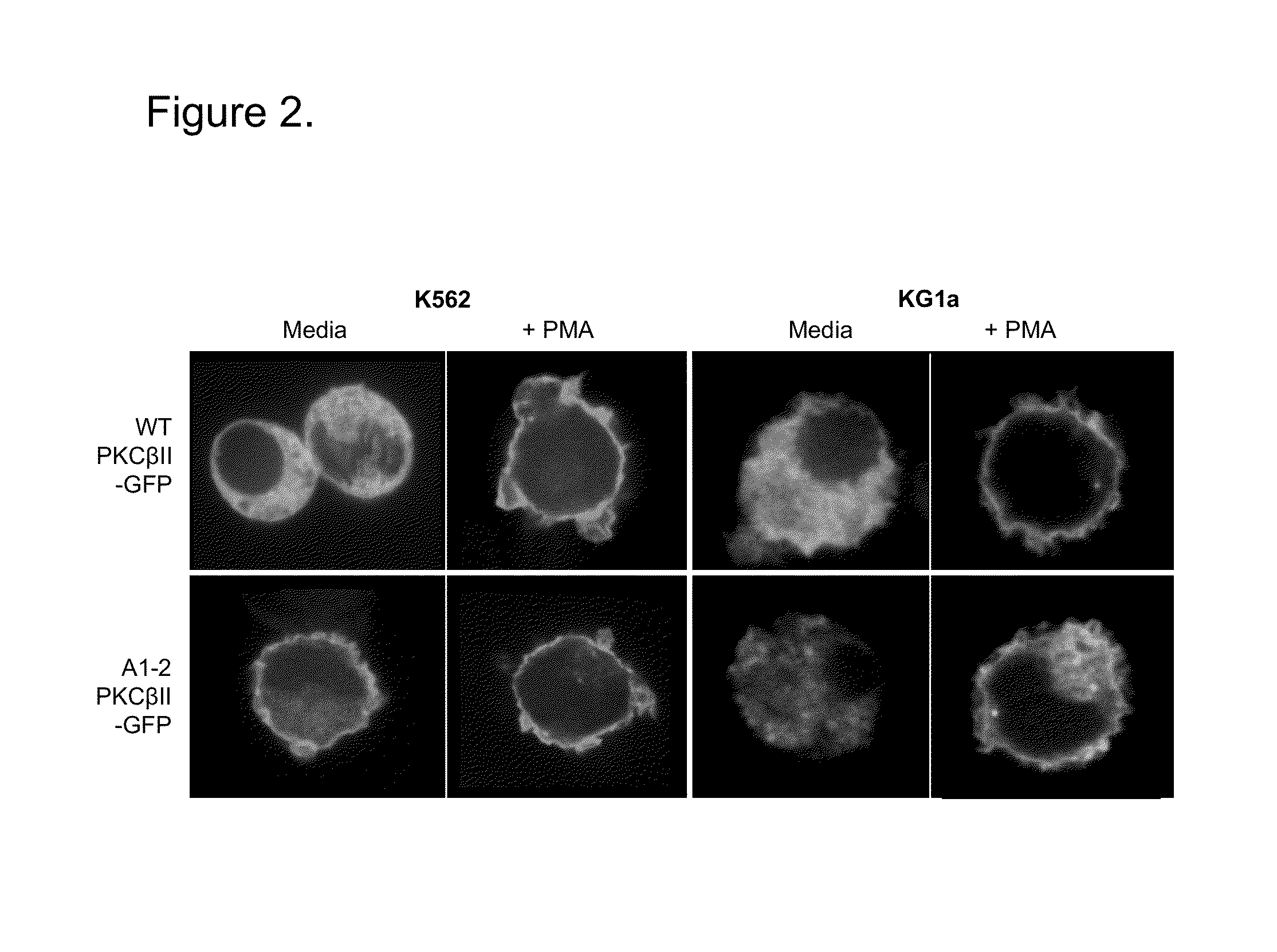Prodrug anti-cancer therapy
a prodrug and anti-cancer technology, applied in the field of cancer therapy, can solve the problems of complex search for cancer therapies, cancer remains a significant cause of death in humans throughout the world, etc., and achieve the effects of inhibiting the growth of cancer cells
- Summary
- Abstract
- Description
- Claims
- Application Information
AI Technical Summary
Problems solved by technology
Method used
Image
Examples
example 1
[0040]This Example illustrates one embodiment of the present invention, whereby growth of CML cells is inhibited via administration of a pro-drug to the cells in the form of a genetically modified PKC βII comprising the Abl kinase target motif (Ala-X-X-Ile-Tyr-X-X-Phe / Pro), wherein the CML specific enzyme Bcr-Abl phosphorylates the PKCβII pro-drug to convert it to an activated drug form, thereby causing PKC-mediated inhibition of the growth of the CML cells.
[0041]Construction of A25Y PKC βII mutants. Substitution of Ala25 with the phosphomimetic residue Glu results in a constitutively active PKC. We tested whether mutation of Ala25 in the auto-inhibitory pseudosubstrate domain of PKC βII to a phosphorylatable tyrosine (A25Y) within an Abl target motif would, upon direct Bcr-Abl phosphorylation, introduce a negative charge and cause disassociation of the pseudosubstrate domain from the catalytic site, resulting in PKC βII activation (FIG. 1A). This Bcr-Abl-activated PKC βII signaling...
example 2
pTAT-A25Y PKC βII-GFP Construct
[0047]This Example demonstrates development of pTAT-A25Y PKC βII-GFP construct for use in delivering the prodrug to cells.
[0048]In order to deliver the A25Y PKC βII-GFP proteins to cells and in vivo, we cloned the cDNA constructs into the pTAT-HA vector, which adds the HIV TAT transducer domain (plus the HA tag) to the N terminus of the A25Y PKC βII-GFP. The incorporated HIV TAT transducer domain has been shown to allow large proteins to readily cross cell membranes and diffuse intracellularly in vitro and in vivo. This vector can be transformed into bacteria and production of the encoded protein induced by the addition of IPTG. This construct also introduces 6 histadines (His6) into the protein that allows for purification of the protein over a nickel bead column, as well as an HA tag that allows for the Western blot analysis for this epitope. The pTAT cector was digested with XhoI and filled in to blunt the 3′ cloning end, the 5′ end was digested wit...
example 3
[0053]This Example demonstrates that Mutated PKCBII translocates to the plasma membrane in Bcr / Abl+K562 but not Bcr / Abl−KGla cells.
[0054]Upon activation, PKCBII translocates from the cytoplasm to the plasma membrane. To determine the activation status of PKCBII through translocation to the plasma membrane, WT and A25Y PKCBII-GFP mutants were Amaxa nucleofected into K562(Bcr / Abl+) and KGla (Bcr / Abl−), and then visualized using confocal microscopy either after no treatment in media, or 30 minutes after PKCBII agonist PMA treatment. As seen in FIG. 10, the WT PKCBII-GFP construct is cytosolically localized in media treated Bcr / Abl+, K562 cells; upon addition of PMA however, the enzyme translocates and is primarily localized to the plasma membrane. A similar trend is observed in Bcr / Abl-KGla cells, where prior to PMA addition WT PKCBII-GFP is localized to the cytosol and only after PMA treatment does it translocate to the plasma membrane. In contrast, the A1-2 A25Y PKCBII-GFP mutant is ...
PUM
| Property | Measurement | Unit |
|---|---|---|
| drug resistance | aaaaa | aaaaa |
| confocal microscopy | aaaaa | aaaaa |
| electrophoretic analysis | aaaaa | aaaaa |
Abstract
Description
Claims
Application Information
 Login to View More
Login to View More - R&D
- Intellectual Property
- Life Sciences
- Materials
- Tech Scout
- Unparalleled Data Quality
- Higher Quality Content
- 60% Fewer Hallucinations
Browse by: Latest US Patents, China's latest patents, Technical Efficacy Thesaurus, Application Domain, Technology Topic, Popular Technical Reports.
© 2025 PatSnap. All rights reserved.Legal|Privacy policy|Modern Slavery Act Transparency Statement|Sitemap|About US| Contact US: help@patsnap.com



